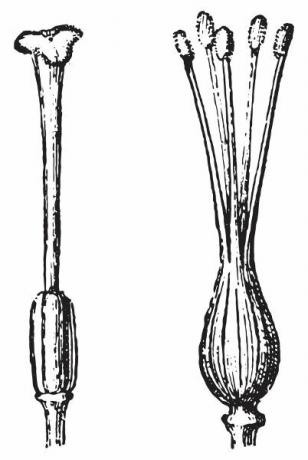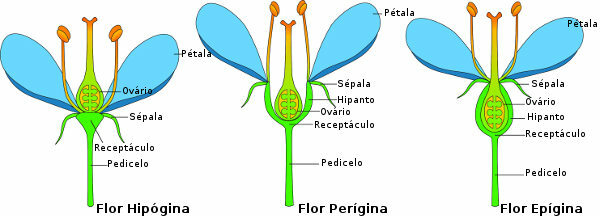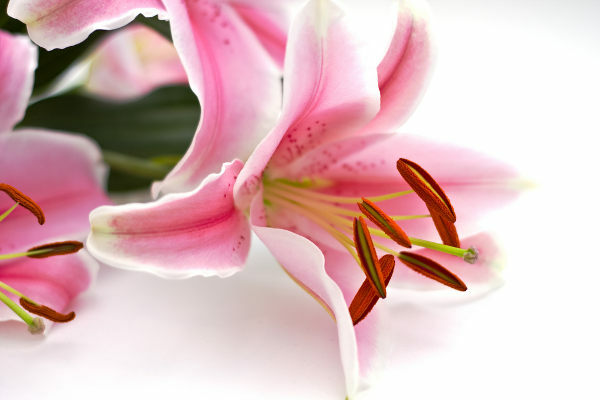gynoecium is the name given to the set of carpels of a flower. The carpels, in turn, are the part of the flower in which the eggs are located, which contain the female gametophyte (embryonic sac), which produces the female gamete (oosphere). Because of this characteristic, the gynoecium is often called part flower girl. A flower can have one or more carpels, which can be separated or fused together.
→ Gyneum classification
According to the amount of carpels it has, the gynoecium can be classified into:
Unicarpelar: formed by only one carpel.
Pluricarpelar: formed by several carpels.
Knowing that the gynoecium can be formed by one or more carpels, we can also classify it according to the fusion or not of these carpels:
Simple: formed by only one carpel.
Apocarpic: formed by free carpels.
syncarpic: formed by united (fused) hoods.

In the figure above, it is possible to observe a simple carpel and a gynoecium formed by fused carpels.
→ carpel parts
In most flowers, the carpels can be differentiated into three parts: stigma, stiletto and ovary.

Note the main parts of the carpel.
Stigma: place that receives the pollen grain (structure that contains the male gametophyte). Stigma generally has substances that facilitate the adhesion of pollen and provide a favorable environment for its germination and for the development of the pollen tube. Formed after the germination of the pollen grain, this tube leads the male gametes into the egg.
Stylet: narrow, tubular region of the carpel where the pollen tube grows. In some flowers, it is not possible to differentiate the stylet. If the flower carpels are fused, there can be only one stylet or one stylet per carpel.
Ovary: lower, dilated portion of the carpel that surrounds and protects the eggs, which are connected to the ovary through a structure called funicle. After fertilization of the flower, the ovary will develop into fruit, and the egg will give rise to seed.
Read too: double fertilization
In fused carpels, the ovary is often divided into two or more locules, places where the eggs will be. The number of locules will depend on the number of carpels present in the gynoecium. Thus, according to the number of locules they have, we can classify the ovaries into unilocular, biocular, trilocular, tetralocular, pentalocular. It is noteworthy that, in some cases, even if the gynoecium is formed by several carpels united, there is only one loculus present due to the absence of separating walls.
→ ovary position

Insertion of the ovary allows us to classify flowers into hypogyny, perigyny or epigyny.
Analyzing the insertion of the ovary into a flower, we can classify it into super or hell. As for the flower, it can be classified into hypogyny, perigyny and epigina.When the sepals, petals and stamens are inserted below the ovary, we say that the flower is hypogyny, and the ovary is super. In some flowers, there is a cup-shaped structure (hypanthus) that surrounds the gynoecium and has stamens, sepals and petals on its edge. These flowers are called periginas, and the ovary, in this case, is super. There are also flowers in which the hypanthus is fused to the ovary, and the stamens, sepals and petals are inserted into the upper part of the ovary. In that case we have flowers pages and ovary hell.
→ Placentation
The part of the ovary where the eggs originate and remain attached is called the placenta. This placenta can be organized in different ways, this arrangement being known as placentation. The most common types of placentation are:
Axillary: the eggs arise in a central column formed by tissue from the plurilocular ovary. In the case of axillary placentation, the number of locules formed normally indicates the number of carpels that formed that gynoecosis.
Parietal: the eggs originate in the wall of the ovary. In this case, the number of placentas indicates the number of carpels.
Free Central: eggs originate from a central column in a unilocular ovary.
Basal: a single egg or more eggs are found at the base of the ovary.
Apical: a single egg or more eggs are found at the apex of the ovary.
Read too: Carnivorous plants
→ Difference between carpel and pistil
It is very common for people to use the terms “pistil” and “carpel” as synonyms, however, some authors consider this name a mistake. According to biologist Judd and contributors to the book Plant Systematics: a Phylogenetic Approach, the pistil is the structure in the center of the flower that carries the eggs, and the capello are the basic units of the gynoecium, which can be free or fused. When the carpel is free, it is synonymous with the pistil. When the carpels are fused, however, these terms are not equivalent, as each carpel would then be a unit within the pistil.
→ Gyneceus and androces
O gyneceous is formed by carpel set of a flower. Oandroceis formed by set of stamens (structures formed by the anther and fillet) of a flower. In the gynoecium, there is the egg, which contains the embryonic sac (female gametophyte) and the oosphere (female gamete). In the androceu, in turn, we have the anther, which will produce the pollen grain, a structure that contains the male gametophyte, which will give rise to the male gamete (spermatic nuclei). Thus, we have that the gynoecium and the androecium are the fertile parts of a flower.

The lily is a perfect flower, as it is possible to observe the androceu and the gynoecium in it.
The flowers can have only gynoecium, only gynoecium, or gynoecium and androcoe only. are called perfect flowers those who have gyneceous and androca. Flowers that have only androceu are called staminate. Those who have only gyno are classified as pistillate or carpellate. Staminate and pistillate flowers are called imperfect.
→ Summary
The gynoecium, also called the female part, corresponds to the set of carpels on a flower. In a flower, you can find a single carpel or several carpels, which may or may not be fused together. Analyzing the carpel, we can observe three basic parts: stigma, the place that receives the pollen grain; stylet, where the pollen tube grows; and ovary, the dilated portion that contains the eggs. After fertilization, the egg will form the seed, while the ovary will give rise to the fruit.
By Ma. Vanessa Sardinha dos Santos
Source: Brazil School - https://brasilescola.uol.com.br/o-que-e/biologia/o-que-e-gineceu.htm
